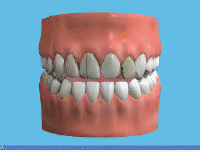
Fixed dentures, also known as bridge, crown, veneer, are dentures which are used in the absence of a few teeth and affixed to the teeth after preparation and shaping (cutting, reduction) of the abutment teeth in the laboratory. Compared to removable dentures, it is accepted by the patient more easily, but some conditions need to be fulfilled in order for it to be applied. Cleaning of these dentures is very important in terms of longevity. Especially all the gum margins of the abutment teeth should be brushed very well. Following the measurement and preparation of the teeth, the procedure is completed in 3 to 4 sessions and 1 to 2 weeks. The dentures have a lot of variety under the title of metal-supported porcelain and metal-free structures. The most appropriate solution for your oral cavity will be determined with your dentist.
If dental caries and loose teeth are in such an advanced stage that they cannot respond to other treatment methods, the teeth are extracted. As a natural result of this, toothless gaps show up in the mouth. If the gaps are small and not seen from the outside of the mouth, there is no immediate need for dentures. Because the oral environment of the individual can tolerate such small gaps. If this small gap is seen from the outside, then there is an aesthetic problem and this problem should be solved with dentures urgently. At the back of the mouth, depending on the number of teeth extracted, if the toothless gaps grow, these gaps must be filled with dentures. Because the chewing function is adversely affected first of all.

In this system, zirconium is used as a substructure material instead of metal. Studies have shown that the highest performance ever achieved was recorded in aesthetics, durability, histocompatibility and naturality which are the basic requirements of dentistry. It is a method which was created completely as a result of the combination of computer-aided technology and hand-craft. Tooth preparations(cutting) prepared in the clinic are formed with special methods in the laboratory and read by 3d scanning system with the help of a special device. This information is transferred to the shaping chamber of the device and processed by crown or bridge computer. Thus, zirconium oxide substructure is formed. This substructure is coated with a special porcelain. Thus, translucent (with neon effect), very durable, aesthetic, natural-looking crowns and bridges are obtained. The biggest advantage of the system is that porcelains are easily used in bridges with the its high durability.

With this type of porcelain, it became possible to construct dentures applied to only the front surfaces of the front teeth that are the key of our aesthetics. With this technique called ‘laminate veneers’, permanent applications with perfect color and tissue match can be done by removing a small amount of material from the front surface of our teeth.